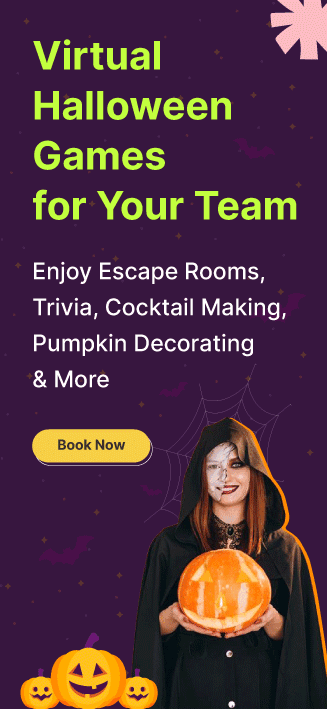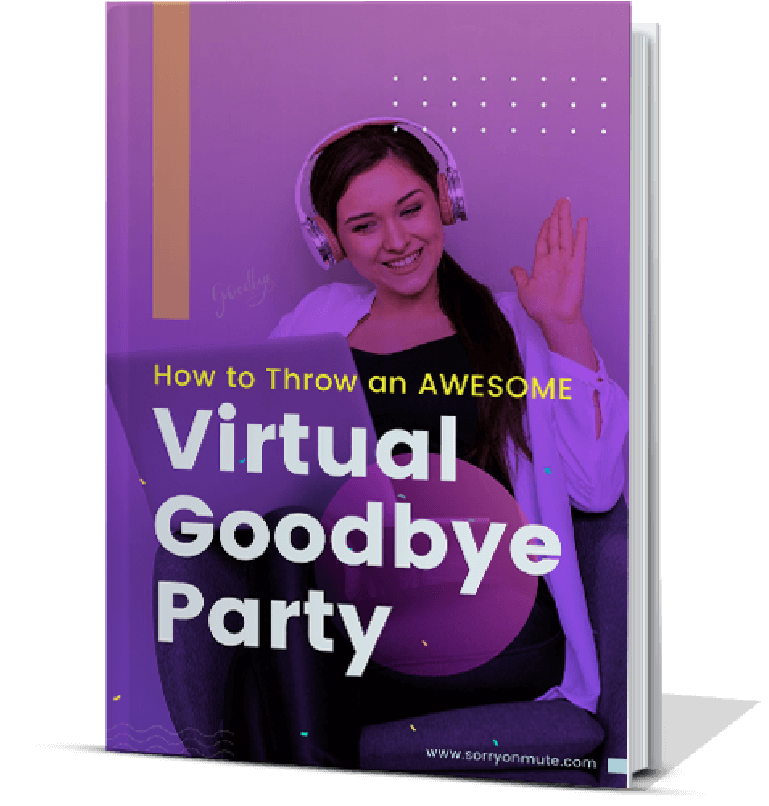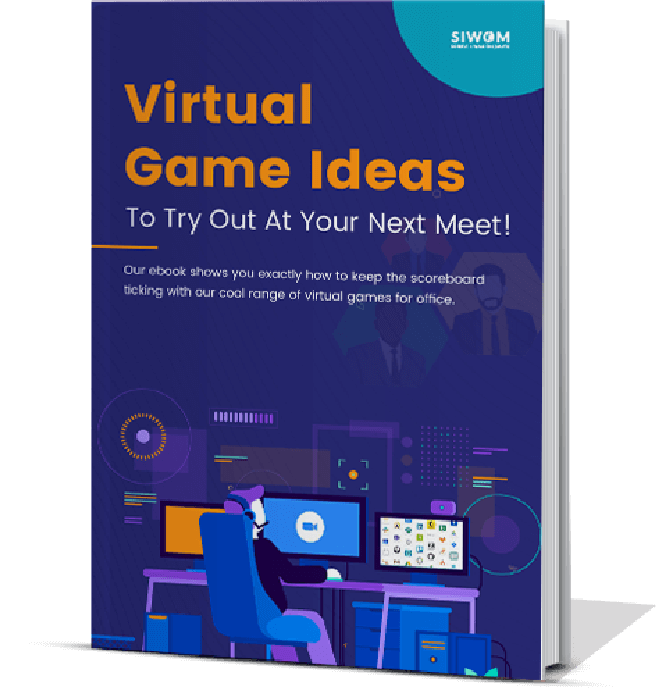1. What is an Online Scavenger Hunt?
An online scavenger hunt is exactly what it sounds like — a version of a scavenger hunt that is played by participants via the internet. Participants are provided with a list of items they have to find or tasks they have to complete within a specific time frame. Generally, the goal is to find, collect, or complete the tasks fastest to win.
In most cases, playing scavenger hunts will require exploratory skills, analytical abilities, and teamwork. You typically have to leverage video conferencing platforms like Zoom or Google Meet to arrange a virtual Halloween scavenger hunt.
2. 12 Best Virtual Halloween Scavenger Hunt Ideas
2.1 Hosted Virtual Scavenger Hunt
Hooray Teams Virtual Halloween Scavenger Hunt is a spooktacular way to add a dash of fun to your remote team’s day. Unlike other Halloween scavenger hunt ideas, this one is hosted by a professional game master from start to finish. Participants will get a list of items via an online application or a shared software platform. They must fetch each listed item within the timeframe and show it by clicking a photo or presenting it live on camera. The host will provide the necessary hints along the way.
Here are some possible ‘eerie’ clues you could be asked to uncover:
- Witch hat
- Broomstick
- Pumpkin
- Candy corn
- Scary mask
- Antique lantern
- Spiderweb
2.2 Virtual Halloween Olympic Games by Hooray Teams 👻 🥇

The Virtual Halloween Olympic Game is a virtual event where you and your team dive into the action with a series of Halloween-themed challenges. This isn't your average event—it's a thrilling expedition into the ghostly unknown! It's a mini-game tournament where your group gets divided into teams to compete in various Halloween-themed challenges. From a trivia showdown to a zombie scavenger hunt and an eerie game of monster Pictionary, each task is designed to keep your heart pounding. To add an extra layer of fun, your team can dress up in Halloween costumes to make it more spook-tacular!
The event is hosted by a professional who ensures that everything runs smoothly. You can even personalize the trivia to include secrets and fun facts about your team, adding an extra layer of excitement to the games. The best part is that this event is hassle-free for large teams. There's no need for any extra microphones or technology – simply click the provided link, and the host will take care of everything. It's a fantastic way to celebrate Halloween with a unique blend of competition, knowledge, and fun, all from the comfort of your home/office.
SIWOM Fun Rating - ⭐⭐⭐⭐⭐
For more such thrilling activities, explore our latest article on murder mystery team building.
2.3 Pumpkin Decorating Contest

As the name implies, a pumpkin decorating contest during a virtual Halloween scavenger hunt means that participants get to showcase their carved pumpkins on camera. This activity invites participants to present their carved pumpkins on camera, providing an opportunity to explain their design choices and walk the other participants through their carving process.
Each pumpkin will be evaluated based on specific criteria such as the "Most Creative" category, which celebrates originality and innovative design, the "Spookiest" category, recognizing those that evoke a chilling ambiance, and potentially a category for the "Best Halloween Story," honoring pumpkins that weave a compelling tale of the macabre.
SIWOM Fun Rating - ⭐⭐⭐⭐⭐
2.4 Halloween Movie-Themed Objects
In this case, you’ll provide participants with a list of several items related to Halloween movies. For example, you could include items like a vampire’s teeth or a witch’s hat on your list. Participants must then quickly search their homes and return to display these items on camera.
Of course, the fastest participants get the point or score the highest. To make it more interactive, you can ask the fastest participants to share their favorite movie scene for the specific object.
SIWOM Fun Rating - ⭐⭐⭐
2.5 Ghostly Greetings
In this case, you’ll need to prepare a list of Halloween-themed words or phrases. The clock will be ticking as participants dash around their environment, searching for the perfect items that seamlessly match the Halloween words or phrases. Quick thinking and an eye for detail will be essential in this high-energy challenge.
Once the objects have been collected, participants will present their findings, aiming to impress the judges with the relevance and creativity of their selections. The judges will evaluate both the speed of the search and the appropriateness of the items chosen in relation to the Halloween-themed words or phrases
SIWOM Fun Rating - ⭐⭐⭐
2.6 Mystery Riddles
With mystery riddles, you’ll need to craft a series of riddles that provide cryptic hints about where participants should look or go. As they figure out the answer to each riddle, they’ll discover the location for the next clue until they find the final object.
Since you’re playing virtually, you can prepare clues that lead participants to popular websites or online channels that can be accessed by every player. can be related to spooky places, famous monsters, or Halloween traditions.
SIWOM Fun Rating - ⭐⭐⭐⭐
2.7 Candy Craze
In this virtual Halloween scavenger hunt, the goal is to create groups of different kinds of candy based on shapes, flavors, etc. Another variant of this game is to compile a list of different Halloween candies (e.g., candy corn, chocolate bars, gummy worms). Then, participants must quickly find and display each candy on camera.
A fun twist you can add to this game is to release the list of candies in segments. This way, participants must challenge their memory to remember what candies they have to find.
SIWOM Fun Rating - ⭐⭐⭐
2.8 Haunted Home Tour

In a Haunted Home Tour, participants take other players on a virtual tour of their homes, displaying spooky decorations, eerie settings, and other Halloween-themed items. Aside from this being a fun icebreaker or detour, it also motivates and inspires others during their Halloween decoration process.
SIWOM Fun Rating - ⭐⭐⭐
2.9 Halloween Costume Challenge
This one is fairly straightforward — the best Halloween costume wins!
Participants can attend the virtual Halloween scavenger hunt in their costumes. You can then take turns judging each costume based on creativity, authenticity, and flair. Another variation to this game is asking participants to guess the character others are dressed as. However, such answers are almost straightforward and clear to see.
SIWOM Fun Rating - ⭐⭐⭐⭐
2.10 Witch's Brew Ingredients
Here, you’ll need to provide a list of ingredients that can be potentially found in a “witch’s brew.” Some ideas include the eye of a newt, a spider’s leg, a feather from an eagle, and more. Participants will need to quickly find items around their homes that could match these ingredients and then display them creatively on camera.
Just as a clarification, these are not real ingredients. What participants need to do is find objects that have the potential to emulate these ingredients. Scoring in this virtual Halloween scavenger hunt would be done on timing and authenticity.
SIWOM Fun Rating - ⭐⭐⭐
2.11 Horror Movie Trivia Hunt
With a Horror Movie Trivia Hunt, you’ll need to design or find trivia questions related to popular horror movies. Once you present each question to your participants, they’ll need to solve or answer the question to advance in the scavenger hunt. The questions may cover a wide array of topics, from iconic scenes to famous characters and quotes.
SIWOM Fun Rating - ⭐⭐⭐⭐
2.12 Monster Mash-Up

Here, participants use different household items to create a "monster mash-up." For instance, they might combine a candy wrapper and a toothbrush to make a ghoulish tooth fairy or classic ones like tissue for mummies. The goal here is to be as creative as possible with no pressure. So, encourage participants to get creative.
Remember, each idea brings a unique twist to the hunt, ensuring a mix of fun, creativity, and Halloween-themed engagement.
SIWOM Fun Rating - ⭐⭐⭐
3. How to Plan the Best Virtual Halloween Scavenger Hunt
3.1 Select Your Theme
The first thing you want to do is decide on a Halloween-related theme for your virtual Halloween scavenger hunt. This adds a bit of creativity, thrill, and excitement to the mix and sets the tone for your participants. Some examples of Halloween-theme ideas for you include “Haunted House Mystery.” or “Zombies of the Night”.
3.2 Choose an Online Platform
Since your Halloween scavenger hunt is happening virtually, you’ll need an online platform with compatible features such as breakout rooms and screen sharing that allow participants to meet and interact seamlessly. Popular options include Zoom, Google Meet, and Microsoft Teams.
3.3 Prepare a List of Clues
Next, you’ll need to create a list of clues or prompts that will point participants in the direction of the virtual "hidden" items. Depending on your specific gameplay, this may include questions, riddles, and more. Your clues should be Halloween-themed to stay in context to the narrative or related to common ground among participants.
3.4 Communicate Rules and Timings
Ensure all participants are aware of the rules and guidelines that will govern the virtual Halloween scavenger hunt. This includes details on timing, scoring, props, and more. This way, everyone knows what to expect during gameplay.
3.5 Send Out Invitations in Advance
Next, send out digital invitations before the game day so that everyone can prepare their online platforms. You should include details about the event, including the theme and other requirements. Don’t forget to add the date and time too!
3.6 Host the Event
Once participants have gathered your chosen online platform on the appointed date and time, you can kick off the event. You should start by introducing yourself and the role you’ll take during the virtual Halloween scavenger hunt. Then, you can move on to explaining the gameplay and rules. As the host, try to set a fun and exciting tone for the hunt experience.
3.7 Begin the Hunt
Share the first clue with participants and let them start deciphering it. As they solve each clue, they'll move through different online spaces, finding virtual items or completing tasks.
3.8 Reward the Winners
Everybody may be a winner, but someone finishes first. Once participants have reached the final checkpoint, you can end the game by announcing the winner. In addition to acknowledging the best scavenger hunt player, you can also reward them with Halloween-themed prizes or other gifts.
Remember, the key to an exciting virtual Halloween scavenger hunt experience is to keep participants engaged throughout the event.
4. FAQs
4.1. How to do a scavenger hunt over zoom?
You’ll typically start by choosing a theme, establishing the rules of gameplay, and creating a list of items or clues participants need to find in their own homes. You can then send the invitation to participants while sharing the rules with them. During the Zoom call, share the list with participants and wait for the fastest person to find all the items.
4.2. How to do a scavenger hunt for Halloween?
First, decide on the theme of the hunt — whether it's based on a Halloween movie or spooky riddles. Next, create a list of items, clues, or riddles that align with the theme. Finally, provide participants with the list of clues and let them embark on the hunt, either individually or in teams. Once the hunt is complete, gather everyone to discuss their findings and perhaps reward the most successful participants.
 Interested in Virtual Team Building Events?
Interested in Virtual Team Building Events?






















